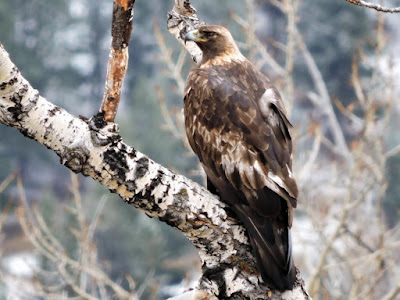Are you looking for some winter time birding opportunities that contribute to a large citizen science project? The Winter Raptor Survey Project is looking for volunteers to run winter raptor routes in the north half of Ferry County, Washington. The Project has coordinated with Northeast Washington Birders the past two seasons to run four routes in northern Stevens County. We are now looking to establish one or two routes in the north half of Ferry County. The project is an effort to get a better understanding of the biology of wintering birds of prey in the Pacific Northwest. Winter Raptor Routes are run by hundreds of volunteers in northern California, Oregon, Washington, and Idaho.
WHAT IS INVOLVED?
Winter raptor routes are typically 25-40 miles long and are driven one day each month from November through the following March. A data collection sheet is filled out by the observers and returned to Northeast Washington Birders for a data check and then forwarded to the project coordinator. The project coordinator works for the East Cascade Audubon Society in Bend, Oregon, the overall project sponsor.
- Two observers are typically needed (one to drive and one to record) but one person can manage if they are well organized and practice safe driving.
- The exact routes are being developed. We are looking at one or two routes that encompass the Sanpoil River valley and Republic area, and another route encompassing the Curlew Lake - Kettle River valley area.
- This is a volunteer citizen science project. Observers will not be reimbursed for their time or vehicle mileage.
- Each route is divided into segments and the numbers of each raptor species (birds of prey) observed in each route segment are tallied.
- Observers must be able to correctly identify the typical hawks, falcons, eagles, and owls that occur in their area during the winter months.
- Observers must dedicate one day each month from November through the following March to run their route. Routes can typically be run in 3-4 hours and should be driven in the morning hours.
- Observers need a vehicle suitable for winter driving on county roads and/or state highways. Observers must be ready and dressed for winter conditions, including stepping out of vehicles to make observations, as needed. Extensive walking is not needed on these routes.
- Data sheets from each month must be sent to Northeastern Washington Birders, either by email or snail mail, before the end of each month of the survey period.
ARE YOU INTERESTED?
If you are interested in volunteering for this project then contact Northeast Washington Birders at newbirders@gmail.com or Facebook Messenger @NEWAbirders. You can also text or call 509-675-9375. You may also respond by entering a Comment in the Comment section below.
We are especially interested in local Ferry County birders familiar with winter- occurring raptors and can dedicate the time needed to complete the monthly routes. But we are also open to birders from adjacent areas. Observation teams may consist of more than one vehicle and/or more than two observers.
If you are interested please respond by September 11, 2021.
Good Birding,
- Hawkeye
























